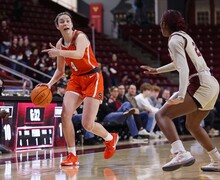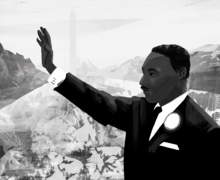Cliff Ensley earned everything. Now, he’s giving it all back.
Courtesy of Sue Ensley
Ensley and his wife, Sue, stand in front of the Ensley Athletic Center, which he helped finance.
To understand why a former walk-on football player would donate millions of dollars to his alma mater, you must first know the man behind the check.
Cliff Ensley is the last Syracuse three-sport letterman. He turned a $2,500 investment into Leisure Luggage, a multimillion dollar operation. He once added 15 pounds to jump up weight classes before the NCAA wrestling tournament to allow a teammate to pursue a national title in his former weight class.
“I didn’t really answer to anyone,” Ensley said. “I had my own set of goals and my own motivation. But it was always just do the best you can and see where it leads you.”
On Oct. 14, SU Athletics will reveal Ensley’s latest contribution, statues of former Syracuse lacrosse coaches Roy Simmons Sr. and Jr. This comes after he recently donated several million dollars to build an indoor turf football facility in 2015.
Ensley considers this the latest bronze veneer in preserving a legacy he helped create. He often travels from his home in Edison, New Jersey, to a second home in Cazenovia — about 18 miles from SU’s campus — to watch games of the players he still calls “teammates.”
He has always seen life through this context. Ensley stopped wrestling in college to focus on football and lacrosse. Growing up in Scarsdale, New York, his efforts at defensive end and wide receiver didn’t earn him any all-league accolades, but he kept playing because he liked playing sports — even though he didn’t think the town wasn’t big on them.
More than 50 years later, he donated the building that became the Ensley Athletic Center, a massive, white-paneled facility across from South Campus. Yet the building that bears his name isn’t his favorite contribution.
“I think it’s a way of saying, ‘You never appreciated me when I was first starting out, but I’m appreciating Syracuse now,’” said former SU football coach James Ridlon.
Zero Division I schools recruited Ensley, the defensive back one coach called a “skinny little guy,” but he walked on at SU anyway. The tryouts started with 20 players until two weeks later, when only one remained. Coaches remember how hard Ensley pummeled All-American running back Larry Csonka in practice. So, that spring, then-head coach Ben Schwartzwalder awarded him a scholarship.
In Ensley’s sophomore season, when receivers consistently burned aggressive defensive backs for long plays, at least one backup adjusted by playing a step back. Ensley understood his role: don’t allow the big play. He provided his receivers a cushion, preferring to defend short passes rather than deep balls over his head. He wormed his way into the rotation, earning a start in the season’s third game. Ensley started every game after.
“I think I’ve always had that attitude, start at the bottom and work your way up,” Ensley said. “I’d done that in grade school and high school, and that’s what I figured I would be doing at Syracuse.”
In 1968, his senior season, Ensley remembered Syracuse punt returners weren’t catching the ball. When they did, they often ran sideways. Midway through the season, Ensley assumed the role, seldom calling for a fair catch and always running forward.
In five games, Ensley fielded 31 punts, the second-highest SU single-season total ever. On Nov. 16, in a record-setting punt-return performance against Navy, Ensley caught a kicked ball as it sailed over his head, like a receiver. The risk proved worth it 76 yards later in the end zone.
“He never really was recognized,” Ridlon said. “I had to to keep telling Ben Schwartzwalder how important he was.”

Andy Mendes | Digital Design Editor
About five years ago, Floyd Little set out in search of donors for a series of statues and a new athletic center. He knew to call the man who had been sending him Leisure Luggage products for years, the man he considered a teammate.
Through talks with Dick and Gene Thompson, Ensley found himself more invested with the center. He discovered the Thompsons were dedicating the field to Gene’s father, a World War II veteran who fought on the beach at Normandy.
Ensley agreed to pay for “(his) share” of the center if SU also memorialized Schwartzwalder, a fellow Normandy soldier. More than 50 years earlier, Schwartzwalder had given Ensley a shot. Now, his former player wants to show the same respect.
Outside the Ensley Athletic Center stands a series of bronze statues. A cluster of them, called “Plaza 44,” contains the replicas of the three legendary SU running backs who donned the number 44: Jim Brown, Ernie Davis and Little, Ensley’s hero.
To their right, the sculpture of an elderly gentleman with glasses and a Syracuse sweater stands alone. He wasn’t supposed to be there. The statue of Schwartzwalder had been dropped when the “44 project” was developed, Ensley said. Then, he stepped in.
Ensley didn’t want his name on the building alone. He wanted Sue, his wife and business partner of nearly two decades, to share that space. But she declined, and Syracuse added her name to an inside wall of the building.
“You can always owe back,” Ensley said, “but a lot of times you don’t get in positions where you can do it, so I did it. I take pride in doing it.”
In 2007, Ensley founded the Orange Memorial Fund, which originally gave blankets with a block letter “S” to the families of deceased Syracuse athletes who lettered in football, wrestling or lacrosse — his sports. He also included boxing, because though he never played, Simmons Sr. coached it.
The inspiration came when Thomas George, Ensley’s teammate and former roommate, died in the early 2000s, and Ensley attended a big town funeral. He thought Syracuse should honor him.
Ten years after the program’s inception, it now covers all athletes. The program delivers a blanket to the family members of any deceased Syracuse athlete, hopefully before funeral services. The blanket always arrives accompanied by a handwritten note:
“From your teammates, you’ll always be remembered.”
Published on October 4, 2017 at 10:56 pm
Contact Josh: jlschafe@syr.edu | @Schafer_44





